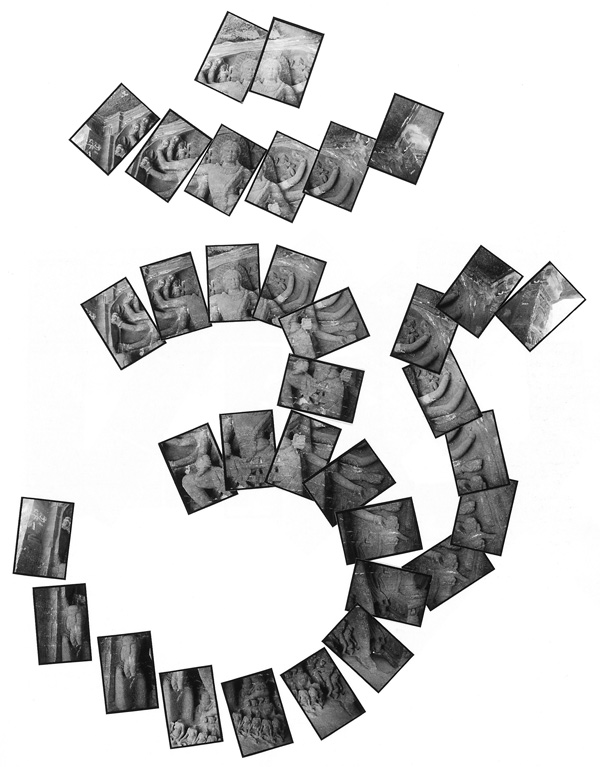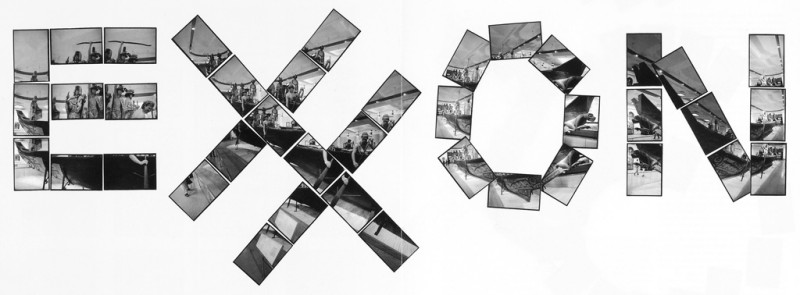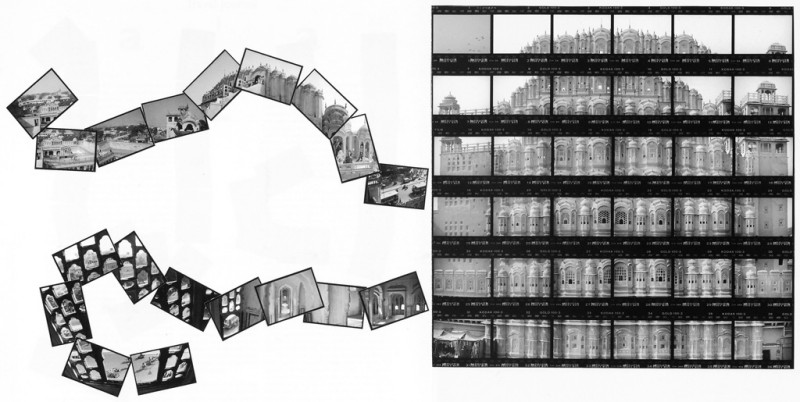[Spring 1995]
by Mona Hakim
Bill Vazan’s fragmented photographs, one comes to understand the necessity of interrogating the very conditions of photography’s procedures, and consequently, those of vision.
Conditions related to what Philippe Dubois adverts to as the “flatness” of the photographic image, an image “reinforced by the monocular nature of the optical device, [and that] offers a unique viewpoint of the object.”1 The author earlier mentions that “the second specific trait characterizing the photographic index, is that which renders it an object-plane at once flat, planar, and fixed.”2 With Vazan, this flatness of the image is non-existent or, at least, purposely annihilated. The figures appear to be in relief, yielding to a categorical inversion of the monocular perspective, that is, receptive to plural vision. Here, we begin to near sculpture, with its volumes and its “physicality,” what is more, we may recall the importance of the role played by sculpture within the whole of Vazan’s oeuvre. As for photography, it has been part of the artist’s production since the end of the 1960s, then used as a means to document his land art projects.
Be it in his sculptures, drawings, or photographs, the content is forever mobile, never frozen: decomposition of the real, reconstruction, formal vibration, and mobility. The artist’s lines, either those engraved on stone, or those of his drawings, zigzagging across the paper’s surface, trace a similar network of ramifications, resembling at times a vascular system, and at others, topographical surveys. The polysemous character of these images may be approached not only from a formal perspective, but also in their referential capacity. History, archeology, topography, ethnography, science, and cosmogony intertwine and weave a crystalline web that travels through time unto our very origins. Hence, the primitive signs of the engraved stone that encroach upon and unfold in a contemporary landscape. Hence, too, the perception of mobility in objects whose internal trajectories seem to want to excavate the earth’s outer crust, and spread out in all directions in an encompassing, planetary system.
This spatial and temporal traversal, inherent in his outdoor sculptures, remains, in part, tributary of an environmental, social, and cultural awareness.
Direct intervention in landscapes is suggestive both of the relation between man and the space he inhabits, and a form of spatial appropriation, or a re-staging of the natural site. Working in or on the landscape juredly contributes to reducing the terrestrial scale to that of the intervener, and analogously, to acquire mastery through familiarity over a given territory and architecture. However, land art is also an experience in perception, in framing, and in the vanishing points of the onlooking eye. And it is precisely at this point that land art encounters photography, which, in turn, becomes its extension. Again, in the words of Philippe Dubois, we are able to see how this type of structural mechanism may be summed up: “Photography, architecture, and installation equally, are machines for sight; that is, machines that fashion reality, construct it according to a game of perceptual norms, rationalize it through a more or less totalitarian shaping.”3
With the six photographs reproduced in these pages, Bill Vazan is pursuing his observation and schematization of the environing world. Aside from Large Glass Globes and Haïda Canoe, the objects recorded by his camera refer to sacred monuments and gothic or prehistoric architecture. An endless return to mythical moments, a re-actualization of events that have marked the course of history, a temporal cleavage. Formally, the construction of these images follows a succession of fixed planes taken directly from the contact sheets and assembled as a mosaic. An assemblage that could be compared to the string of markings dug into rock, apparent in the artist’s sculptures. The content of the photographs is fragmented, and each of the components, subtly out of phase. Contrary to what may emanate at first glance, these works are not of a single image cut, but of a combination of different shots each one marking a specific time and place. An operation of deconstruction and reconstruction into irregular planes whose sequence is left to be reassembled by the viewer. But also (and more so), a recording of the passage of time through these very mechanisms of movement.
In relation to his environmental production, here the artist has reduced his field of vision. The plurality of viewpoints is generated at the precise moment of the shooting, directly on film. Consequently, what is given to be seen in its entirety will hereby have more to do with the various stages of the work’s creation. Are we not, then, at the heart of the “photographic” discourse, with its claims to slices of reality, to illusions of truth, and to procedures of construction, manipulation, and articulation? In Palace of the Winds and Medusa/Apollo, the usage of the contact sheet’s reference strips as grids clearly indicates the presence of photo montage, of procedure, of technicalness, of “counter-illusion.”
Although reducing his field of vision, and despite the extreme exactness of his geometrical combinations, Vazan has nonetheless reiterated the sense of openness and expansion proper to his land art projects. It is precisely because of the woven-like quality of his compositions and his multiple angles of vision that his photographs cannot be apprehended in a monolithic manner. The viewer has the clear sensation of being at once inside and outside of the photographed subject, as though he or she were experiencing the photographer’s behind-camera circumvolutions. Photography, with Vazan, sharpens our diverse perceptions of the world, develops our kinaesthetic faculties, questions our spatial and temporal orientation.
Supporting his position, Vazan turns to a number of scientific hypotheses, notably physics’ superstrings theory: a mathematical model conveying a multidimensional representation of an elementary particle. In other words, the varying angles of a same object contain as many distinct forms. In Palace of the Winds, Medusa/Apollo and, Large Glass Globes, a sense of rotating space becomes imminent, soliciting the viewer’s eye from all sides. According to the artist, they are reversed images, suggestive of a fourth dimension. Large Glass Globes (a reproduction of Duchamp’s The Large Glass) is the product of a triple rotation in space by transposing the recorded subject into a half-dome (or into the double pupil of binocular vision) to create the illusion by association of a single globe. Vazan is paying tribute to the genius of Duchamp, whose work was clearly influenced by scientific research, and more particularly, research concerned with notions of inversion, illusion, and movement.
Haïda Canoe,Why? and Kailasa Temple are works of a more graphic, scriptural nature. In Haïda Canoe, the images of American Indian scenes are assembled to form the word EXXON, a social commentary on the empowering presence of the petroleum industry in First Nation territories. Resembling an Arabic signature, the word Why? flourishes from within the motifs of the Egyptian tomb of Ramose. In Kailasa Temple, the goddess’ arms are multiplied as they spread open like a large fan, simulating a figurative representation of the sound om, the symbol par excellence of the divinity of creative energy. An image of writing that pursues the same logic as the engraved rock calligraphy and the ground imprints in Vazan’s sculptural work. Writing is thus posited as a trace, or better yet, as a trace of images to be read, in the same manner as the sequential planes arc in want of being decrypted. As the artist himself suggests, the image is to be traced by a “seeing pen” (“stylo à vue“).
It appears, then, that Vazan’s production is indisputably comparable to the impressions described by Philippe Dubois regarding aerial photography. A practice that the author rightly links to Supre-matism (Malevich), with its conception of a “new space,” “irrational,” “universal,” “free-floating,” and “rotating.” “An aerial view literally has no direction,” says Dubois. “It can be looked at from all angles, and always remain coherent. It is the suspended, mobile point of view […].”4 Horizon, in Bill Vazan’s photographs, spans in every which direction. Perhaps the artist’s own nomadism traces the lines of vision of a fragmented perspective. Do his puzzle-shaped works not seek to rationalize – at human scale – the creation of the universe? Do they not try to extrapolate the very limits of our field of vision?
Translated by Jennifer Couëlle
1 Philippe Dubois, L’Acte photographique, (Paris: Éditions Nathan, 1990) p. 97 (translated by J. Couëlle).
2 Ibid., p. 96.
3 Ibid., pp. 254-255.
4 Ibid., pp. 231-232.
Bill Vazan moved from Toronto to Montreal, where he has been living and working for many years. In Canada, he is one of the most outstanding artists of his generation. Land art is both the basis and momentum of Vazan’s artistic practice, on which he then comments and documents with other media, including photography.
Mona Hakim is a critic and essayist specialized in contemporary art produced in Montreal, and in addition, is particularly knowledgable of the oeuvre of Bill Vazan. She has collaborated with the Montreal daily Le Devoir and regularly contributes to numerous Canadian art magazines.






![Bill Vazan, Samedi 22 août 1992, Pourquoi? [arabe] (Stylo à vue), sur des bas-reliefs de la tombe de Ramose, Thèbes de l'ouest, Égypte. © Bill Vazan](https://cielvariable.ca/wp-content/uploads/1995/05/30_22_Vazan.jpg)